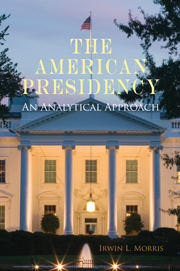Book contents
- Frontmatter
- Contents
- 1 Introduction
- 2 Science and the Study of the Presidency
- 3 The Presidency: Background and Foundations
- 4 Theories of Presidential Power
- 5 Electing a President
- 6 Congress and the President
- 7 The Supreme Court and the President
- 8 The President and the Executive Branch
- 9 The President and Foreign Policy Making
- 10 The President and Economic Policy Making
- 11 Presidential Greatness
- Bibliography
- Index
11 - Presidential Greatness
Published online by Cambridge University Press: 05 June 2012
- Frontmatter
- Contents
- 1 Introduction
- 2 Science and the Study of the Presidency
- 3 The Presidency: Background and Foundations
- 4 Theories of Presidential Power
- 5 Electing a President
- 6 Congress and the President
- 7 The Supreme Court and the President
- 8 The President and the Executive Branch
- 9 The President and Foreign Policy Making
- 10 The President and Economic Policy Making
- 11 Presidential Greatness
- Bibliography
- Index
Summary
Research on presidential greatness has a long history in the study of the American presidency. Collections of presidential biographies often address the relative success and stature of the presidents. While some scholars focus primarily on the set of presidents they consider great – Landy and Milkis's (2001) Presidential Greatness is a prime example – others focus on a subset of presidents that includes the great, the not-so-great, and the failures. In a related literature, researchers construct rankings and ratings, often on multiple dimensions, of all presidents. An excellent example of this type of work is the recent book by Felzenberg (2008), The Presidents We Deserve. In this work, Felzenberg ranks each president on a set of six personal or policy-oriented dimensions, including character, vision, competence, economic policy, preserving and extending liberty, and defense policy (broadly understood). Both of these literatures – one based on no more than a few presidents and the other based on the full complement of presidents – revolve around the development of standards of “greatness” and the evaluation of one or more presidents with respect to these standards. Scholars in this vein define “greatness” and rank the presidents accordingly.
Other researchers study the presidential rankings and greatness scores produced by others. In 1948, Arthur Schlesinger Sr. published a ranking of American presidents based on the results of a poll of eminent historians in Life magazine. The results of that poll placed Lincoln, Washington, and recently deceased Franklin Roosevelt at the top of the list.
- Type
- Chapter
- Information
- The American PresidencyAn Analytical Approach, pp. 235 - 252Publisher: Cambridge University PressPrint publication year: 2010

